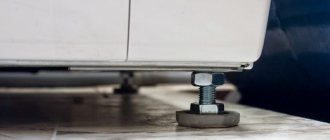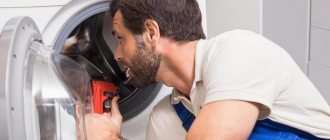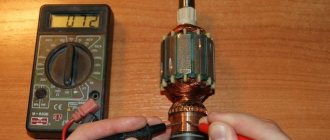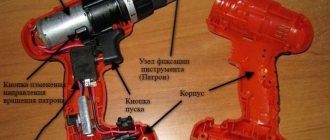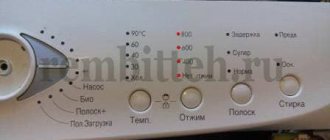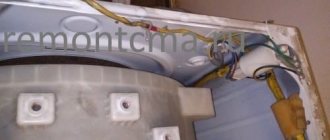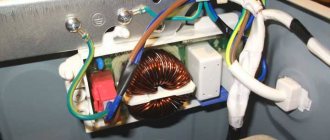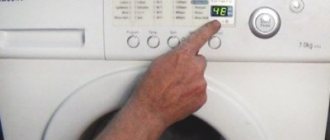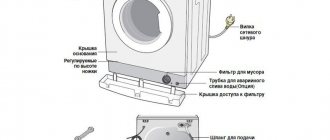It’s somehow even strange to remember that once upon a time automatic washing machines seemed almost a luxury. And not everyone could afford a rather expensive device. And how good it is that everything has changed now. The modern market is replete with a huge range of washing machines for a wide range of consumers - from the most budget machines to expensive luxury models. An automatic washing machine has long become not just an affordable, but rather an indispensable home appliance. And for almost any family.
Unfortunately, the usual trouble-free operation of the washing machine may at some point be interrupted due to various problems. A fairly common complaint from owners of various models of washing machines is a decrease in spin efficiency. For unknown reasons, the machine simply cannot reach the drum speed required for effective spinning.
Is something really broken? Or is this a harbinger of a serious breakdown? Don't rush to conclusions. Let's put aside premature worries. And let’s not rush to contact the service. It’s better to figure it out first - what are the reasons that cause problems in the washing machine, and how can it be eliminated?
Simple problems that do not require repair
Undervoltage
To spin the drum when spinning clothes, the washing machine motor requires more energy than when washing. If the voltage in the home electrical network is too low, the motor simply will not be able to function at full capacity.
Or don’t start the spin cycle at all. You will need to check the outlet with a voltmeter. If the assumption is confirmed, you will have to use a voltage stabilizer. Either “shake” the energy workers or the management company.
Wash program set incorrectly
Almost all automatic washing machines have programs with limited spin speed. Naturally, programs for delicate washing also include a delicate spin. Or its absence altogether. It is possible that the speed control on the control panel was accidentally set to a lower setting or to the “no spin” position. You just need to check the correctness of the set washing parameters.
Protection against unbalance of laundry in the drum is triggered
Most modern washing machines are equipped with an imbalance sensor. This type of protection allows you to avoid serious damage if excessive load occurs on the drum. In any case, it will definitely extend the “life” of bearings and shock absorbers.
Imbalance protection works precisely on this principle: when there is excessive load, the speed is automatically reduced. And if the laundry is not distributed correctly throughout the drum and at low speeds, the spin cycle is completely turned off.
A machine equipped with self-diagnosis will display a signal on the display when the imbalance sensor is activated. In any case, you need to open the door and distribute the laundry evenly in the drum manually. After this, check the spin operation. In most cases it works.
Problems that can be fixed without repair
The following washing machine malfunctions can be eliminated without repair:
- Low voltage in the electrical network. When spinning clothes, the electric motor spends more energy than when washing. If the voltage in the electrical network is low, then the engine will not be able to operate at full power, and accordingly the washing machine will not gain speed during the spin cycle.
- The laundry may not even start spinning . In this case, you need to check the outlet using a voltmeter. If there is low voltage in the network, then you need to install a voltage stabilizer.
- The washing program was set incorrectly . Today, almost all automatic washing machines contain programs that limit spin speed. Probably, the spin speed control located on the control panel of the machine was accidentally set to a low value. Or the spin may be turned off completely.
- Many modern washing machines contain an unbalance sensor . It protects the washing machine drum from serious damage due to excessive loads. The imbalance sensor also extends the life of shock absorbers and bearings. The sensor works in such a way that if there is too much load, the drum speed is automatically reduced. Then the laundry should be correctly distributed throughout the drum at low speed. If this does not happen, the spinning of the laundry is completely turned off. If the washing machine has self-diagnosis, but a signal appears on the display that the imbalance sensor is turned on.
Situations requiring repair
We will consider the problem in increasing complexity. First, of course, with a simpler one, where you can repair a washing machine yourself.
The drive belt is deformed
The belt connecting the washing machine motor drive and the drum has stretched. The speed may not be gained due to belt slippage. You will have to remove the back cover of the car and check the external condition and belt tension. If necessary, replace with a new one.
The drum pulley mount has come loose
In this case, the connection between the shaft and the pulley may be lost. And the latter can simply scroll. The solution is simple - tighten the fastening bolt.
Problem with water level sensor
Due to its breakdown, the control unit will assume that there is water remaining in the car. And he will try to kick her out. The drum rotates at minimum speed. This sensor is located under the top cover of the washing machine. Replacing it will not cause any difficulties.
Engine brush wear
Symptoms may include strange noises and a burning smell. When the brush overhang becomes less than 7 mm, they need to be replaced. You'll have to remove the engine. And changing brushes is not particularly difficult. Of course, this is not relevant for machines with an inverter brushless motor.
The tachometer of the washing machine motor is faulty
It is located directly on the engine. It is precisely this that is designed to control the speed of the engine rotor, and therefore the rotation of the washing machine drum, according to a given program.
Typically the problem occurs due to the tach sensor coil being misaligned. To restore normal operation, you need to fix the coil in its proper place and check the wires. A more serious problem will require replacement.
Washing machine motor problem
A common problem is interturn short circuit. With such a malfunction, the motor “has enough strength” to rotate the drum in the washing mode, but it is no longer able to gain the required speed during spinning. The engine may need to be restored or replaced.
Failures in the control unit
And the last option is that the control unit is “buggy”. It may simply give incorrect commands to the engine. And the spin cycle occurs at the wrong speed. The control unit can be “reflashed” or replaced at the service center.
This is a list of probable causes of weak spin and ways to solve the problem. Almost everything can be easily fixed on your own. Now you know how.
Foam comes out of the washing machine
There is a set of stereotypical malfunctions that happen in most cases with cars of any type and model. This happens because, despite the difference in programs and appearance, they are structurally quite similar to each other. Therefore, with the exception of unique cases, all other faults can be determined with an accuracy of up to 90%.
Some of them can be eliminated yourself. For others, you will have to call a specialist. Such an incident also happens. Any housewife who washes tulle curtains in a washing machine has encountered it at least once. Excessive foaming of the fabric structure occurs. It becomes crowded in the tank and it begins to leak out of the technical holes. In this case, there is no reason to worry.
- Please note, did you choose the same washing program as usual? Perhaps operating at low speeds is simply a consequence of choosing an appropriate program that does not involve intensive washing and spinning. Often such modes are called “delicate” or “gentle” washing, etc.
- Check whether you yourself have switched the device to a lower number of revolutions - in many machines you can adjust the number of revolutions per minute. You could simply hook the regulator or the speed reduction button, and there is no question of breakdown.
- If your choice was correct, and the program was normal, the regulator is at a high rpm, and the machine doesn’t even think about accelerating, then you should stop the washing process, take the laundry out of the drum and estimate how many kilograms you put in the machine . You probably want too much from the device and have overloaded the washer. If the drum is really full of laundry, then divide the clothes into 2 batches and spin each batch separately.
- By the way, sometimes this behavior of the machine can be not only due to overload, but also vice versa - due to insufficient weight of the laundry. Experienced housewives advise putting a terry towel with the laundry that the machine cannot wring out.
- A common cause of failure with weak speed is unbalanced laundry. Maybe all the things are gathered in the duvet cover or just tangled in a “Gordian knot”. You need to stop the spinning, untangle and put things away, and start the spinning process again.
We invite you to familiarize yourself with the Bosch Serie 2 SPS 40E02 dishwasher - instructions for use. If everything described above does not apply to your case, then we are most likely talking about a more serious failure.
If you don’t have time to look for a breakdown, and especially if you don’t understand this very complex electrical appliance, we advise you to entrust the repair to a good technician. We offer you our repair and diagnostic services for the repair of washing machines:
- Repairing a washing machine at home - calling a technician is free.
- All spare parts for machine repair are of high quality.
- Discounts for pensioners.
- Diagnostics 500 rubles or free if you order repairs from us.
- Warranty on labor and parts, etc.
Incorrect operation
Most often, owners are faced with a situation where the washing machine does not pick up speed during the spin cycle.
The reason for this is improper operation of the device.
In some cases, owners do not have the patience to finish reading the instruction manual, and they make mistakes that cause breakdowns in the future.
If the spin function fails due to overload, the laundry will remain wet and will have to be twisted manually.
Do not forget that switching operating modes must occur when the power is turned off. This nuance is often forgotten. The result of such actions is a failure in the program.
If used incorrectly, the risk of failure of units and parts of the machine occurs in the second or third year of operation, when the warranty expires.
Most problems created due to improper operation can be eliminated independently.
Washer malfunction
The washing machine may not spin well during the spin cycle for various reasons. The most common of them:
- Failure of the pressure switch, the sensor responsible for the water level.
- Damage to the tachometer, the part of the washing machine responsible for controlling rotation.
- Malfunction of the electronic module or programmer.
- Engine malfunction.
- Drive belt failure.
If the pressure switch breaks down, the sensor reports that there is water in the tank, but in reality there is none. The machine continues to operate according to the set program and tries to drain the water, so the spin does not start and the machine runs at slow speed. The solution to the problem is to replace the sensor.
If the tachometer breaks down, a sharp increase in speed occurs, or the speed is too slow. Most often, the problem lies in the displacement of this part of the washing machine. To resume normal operation, it is enough to return it to its place; as a last resort, if such an action does not have an effect, replace it.
If the electronic module breaks down, the machine also does not gain momentum. During repair, the module is re-flashed or completely replaced with a new one. Fixing such a breakdown is considered the most difficult job.
Engine failure. In this case, the engine has enough power to ensure the operation of the unit at slow speeds; when spinning, there is no longer enough power to gain speed. This type of malfunction is quite complex; replacing the engine will require large expenses.
If the drive belt malfunctions, traction decreases, and at high speeds the belt spins idle, which is why the machine does not gain speed.
The cause of most breakdowns is wear of parts, for example, the drive belt, which affects the spin cycle.
Have you checked the number of set revolutions and the program, and everything is in order?
Stop the wash if possible, or wait until the program ends, and check the total weight of the laundry. Sometimes the washing machine does not pick up speed during the spin cycle for the following reasons:
Doesn't spin quickly, is it because of the belt?
- The washing machine is overloaded . If the total weight of the laundry you removed from the machine is higher than the maximum allowed by the program, try loading the laundry into the spin cycle in two parts.
- There is too little laundry in the washing machine. Some washing machine models have a minimum loading weight. Try adding a large terry towel (clean, of course) to your laundry; this will help solve the problem of being underweight.
- There may be a weight imbalance . This can happen if some heavy item is being washed or if many small items get into the duvet cover during the washing process. If the washing machine does not pick up speed for this reason, disassemble and arrange the laundry evenly in the drum and try spinning again.
Below you will find the most common reasons why the washing machine picks up speed poorly or doesn’t pick up speed at all:
| What could be broken? | Causes of the problem: | Repair price: |
| Damage to the pressure switch (water level sensor) | This sensor is responsible for transmitting data to the control module about the actual water level in the washing machine. When it breaks down, it begins to transmit incorrect signals, for example, that there is water in the tank, when in fact there is no water. Thus, the water drainage program continues to operate and the speed is maintained at a minimum. |
Solution: replace the sensor
* The table shows the base price for services. The final cost of repairs depends on the type of breakdown and the cost of spare parts for a specific model of washing machine and is calculated by the technician after an inspection.
** The prices presented are the cost of specialist work and do not include the price of spare parts.
In addition to the above situations, it happens that the washing machine does not spin because the water does not drain. If you see that this is the reason, then we recommend that you read our article on the topic “Why the washing machine does not drain water.”
In any case, if it suddenly turns out that your washing machine does not pick up speed during the spin cycle, do not worry, but call a specialist
Our specialist will promptly carry out free diagnostics, determine the exact cause of the breakdown and carry out qualified repairs. One call - and the problem with turnover will be solved in the shortest possible time.
Source
Other causes of failure
It is difficult to list all the causes of spin system breakdowns. Each model of machine may have its own nuances. Repairing a semi-automatic washing machine yourself will save you a lot of money. Here are the most common errors in the operation of the spin system.
- The motor makes a humming noise, but the spin cycle does not work. This means that the belt connecting the motor and centrifuge pulleys has slipped or broken.
- If, after checking the motor with the device, you are convinced that it is working properly, then the cause may be a faulty thermal relay or step-down transformer. These parts are replaced with new ones without repair.
- Check to see if there are any small things wrapped around the motor shaft that could fly out during the spin cycle and get inside the machine.
- Unevenly laid laundry in the rotor causes the centrifuge to beat and prevent it from starting.
- If the activator and spin motors do not work, check the fuse located inside the machine behind the rear wall. It would be a good idea to disassemble the electrical plug and check the contacts.
